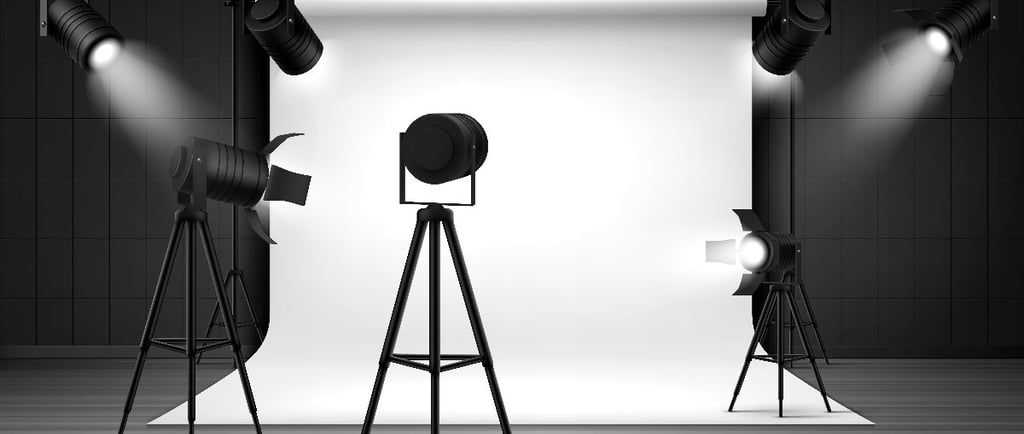How Light Placement Affects Chroma Key Quality
DIGI Acoustics


Introduction to Chroma Keying
Ever watched a movie and wondered how actors seem to be standing on an alien planet? That’s chroma keying in action. It's a technique used in video production to replace a solid-colored background—usually green or blue—with a different image or video. But here's the kicker: the magic of chroma keying doesn't just lie in the software. It's all about lighting—especially where and how that lighting is placed.
Why Lighting Matters in Chroma Keying
Lighting isn't just about making things visible—it's the secret sauce that makes chroma keying look crisp and clean. Think of your green screen like a stage. If the stage isn't lit properly, everything on it (your subject, the backdrop, etc.) will look off. Poor lighting can ruin even the best chroma footage with shadows, color spills, or uneven backgrounds.
The Science Behind Chroma Key Technology
Chroma keying relies on removing a specific color—usually green—digitally. The software detects the green color and replaces it. However, if lighting is uneven, the green isn't consistent, making it difficult for the software to know what to remove. That’s when things start looking messy.
Types of Lighting Used in Chroma Key Studios
Different types of lights play unique roles in achieving that perfect key.
Key Lights
These are your primary lights that illuminate the subject. They're like the sun in your mini studio universe.
Fill Lights
Fill lights soften shadows created by the key light, giving a more natural and even look.
Backlights
Also known as rim or hair lights, these help separate the subject from the background, adding depth to your shot.
Overhead and Background Lights
These specifically light the green screen. They’re crucial for making sure the background is evenly lit without shadows or hot spots.
The Role of Light Placement
Let’s break it down: where you place your lights matters just as much as how many you use.
Even Lighting for Background Consistency
To get a smooth chroma key, your green screen needs to be one solid, evenly lit color. Place soft lights above and to the sides of the screen to avoid gradients or darker corners.
Avoiding Shadows and Hotspots
Keep your subject at least 4-6 feet away from the background. This prevents shadows from falling on the screen and avoids “hotspots” caused by too-close lighting.
Preventing Color Spill
Color spill is when green reflects off the background onto your subject. It makes them look like they’re glowing green—not a good look! Use backlighting to separate them and flags or barn doors to block light spill.
Matching Foreground and Background Lighting
Your subject should be lit in a way that matches the environment they'll be composited into. If your final scene is a sunny beach, don’t use cold, flat studio light—warm it up!
Common Lighting Mistakes in Chroma Studios
Even seasoned creators sometimes slip up. Here’s what not to do.
Uneven Background Illumination
This makes it harder for software to key out the background without leaving rough edges or blotchy remnants.
Using Wrong Color Temperature
Mixing warm and cool lights leads to inconsistent colors. Stick to daylight-balanced lighting (around 5500K) for best results.
Not Isolating Subject Properly
Too close to the background? You'll get shadows. Lit from below? Hello, horror movie! Keep lights angled naturally and maintain distance.
Tips for Perfect Light Placement
Here are some golden rules to live by:
Use Soft Lights for Uniform Coverage
Softboxes or diffused LED panels are your best friends. They give wide, even coverage without harsh shadows.
Light the Subject Separately from the Background
Control is key. Light your green screen with one set of lights and your subject with another. Never mix the two.
Use Light Meters or Apps
You don’t have to eyeball it—there are tons of light meter apps that can help you measure brightness levels for consistency.
Professional Setup Examples
Let’s peek into what the pros use.
Three-Point Lighting System
This classic setup includes:
Key Light – brightest and from the front.
Fill Light – to soften shadows.
Back Light – for subject separation.
It’s clean, versatile, and perfect for interviews or YouTube content.
Green Screen Wall Lighting Grid
In larger studios, LED grids or tube lights are mounted overhead in parallel to cast flawless lighting across the entire green wall—no shadows, no hot spots.
Tools That Help in Perfect Lighting Placement
Can’t do it alone? No problem—here are some must-haves.
LED Panels and Diffusers
Adjustable and reliable, they allow you to tweak intensity and color temperature. Pair them with diffusers for softer light.
Light Reflectors and Flags
Reflectors bounce light where you need it, while flags block unwanted spill. Both give you more control.
Chroma Key Light Measurement Tools
From color meters to waveform monitors, these gadgets ensure your greens stay green (and nothing else does).
Final Thoughts
At the end of the day, your chroma key setup is only as good as your lighting. You could have the best camera, sharpest lens, and the latest software—but if your green screen is blotchy or shadowed, the magic just won’t work. So take your time with light placement, test thoroughly, and remember—good lighting isn’t a luxury, it’s a necessity.
Call us today and let DIGI Acoustics light up your studio with professional-grade solutions — perfect for every shoot!
FAQs
1. What is the best distance between the subject and the green screen?
Keep at least 4 to 6 feet between the subject and the screen to reduce shadows and prevent green spill.
2. Can I use any green color for chroma key?
Nope! Use chroma green paint or fabric designed specifically for video. Regular green may reflect unevenly.
3. How do I check if my lighting is even?
Use a waveform monitor or simply shoot a test video and check for shadows, hot spots, or color inconsistencies.
4. Is it okay to mix warm and cool lights in a chroma studio?
Generally, no. Stick to daylight-balanced lights (around 5500K) for consistency unless you're going for a specific effect.
5. Can I use a blue screen instead of green?
Yes, especially if your subject is wearing green! Blue is often used for night scenes or darker backgrounds.
we provide expert acoustics and soundproofing solutions
Important Links
+91 9100720404
© 2025 DIGI Acoustics. All rights reserved.
2-22-1/173/1, Bhagya Nagar Colony, Kukatpally, Hyderabad, Telangana 500072
Address


